Vietnamese Crème Caramel (Bánh Flan)
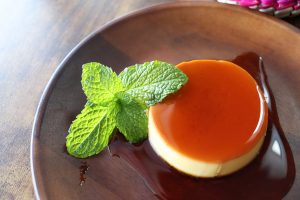
Many people believe that flan belongs to French cuisine and originated in France, but in reality, its roots date back to ancient times, specifically the Roman Empire. This light, cloud-like dessert that melts in your mouth was brought to Europe by the Romans during their conquests. Originally, flan came in both savoury and sweet varieties, using a diverse array of ingredients such as curdled milk, fish, spinach, cinnamon, and almonds. The nutritious dish was commonly consumed during Lent when meat was avoided.
When the French arrived in Vietnam, they introduced flan to the country. This gave us the opportunity to enjoy a smooth and soft dessert with the fragrance of eggs and the sweetness of caramel. Over time, it evolved to include variations with coffee or coconut milk. Globally, flan is now found across nearly all continents. Depending on the region or country, different ingredients are added or omitted to give it a unique local flavour, though the essential characteristics and texture remain largely unchanged.
Today, many still consider flan a French dessert due to its refined taste. Its elegance, perfection, and nutritional value have led to its common association with French origins, even though that’s not entirely accurate.
It’s also recommended to distinguish between flan and the French Crème Caramel to avoid confusion. There are ongoing debates and explanations on culinary forums worldwide, with some arguing that flan and Crème Caramel are two distinct desserts. However, many people accept that flan is simply another name for Crème Caramel, as the foundational structure of both desserts is very similar.

Regardless of the differences, flan continues to be a beloved dessert around the world. It retains the delicate, artistic quality often associated with French cuisine. To make the dessert as a sweet dish for a meal’s end, you only need basic ingredients: eggs, milk, and sugar. Blend the mixture and steam or bake it in a water bath, adding richly coloured caramel for a delightful flan that’s hard to resist.
Bánh Flan has always been one of my favourite desserts, a treat I grew up enjoying in Vietnam. Back then, we only had it occasionally, which made it all the more special. This recipe presents Bánh Flan just as I know it. However, the dessert is quite versatile, and the creative nature of Vietnamese cuisine has led to various other versions. I’ll be sharing these recipes soon, so be sure to check back for updates:
- Coconut Flan (Bánh Flan Dừa): Adding coconut juice or coconut milk gives the flan a distinctive flavour. For coconut lovers, this version is a delicious twist on the classic dessert.
- Cheese Flan (Bánh Flan Phô Mai): Incorporating cheese or cream cheese results in a richer flavour and makes the flan even smoother and more velvety.
- Matcha Flan (Bánh Flan Trà Xanh): Adding green tea or matcha powder gives the flan a beautiful light green colour and a fresh, delicate taste.
- Coffee Flan (Bánh Flan Cà Phê): Infusing the flan with coffee creates a strong and distinctive flavour, combining the sweetness of the milk with the bitterness of the coffee – a perfect choice for coffee lovers.
- Fruit Flan (Bánh Flan Hoa Quả): Mixing in finely ground fruits or vegetables, such as strawberries or pumpkin, introduces new colours and flavour profiles, making it an excellent alternative to the traditional flan.
Here are a few notes on my Vietnamese Crème Caramel recipe:
- I use half-and-half (half milk and half cream) for the milk to give the flan a creamier texture. If you prefer, you can substitute it with unsweetened milk.
- The cooking time for the flan varies depending on several factors, such as the cooking method (oven or steamer) and the size of the ramekins. In this recipe, I steam the flan in the oven using a water bath. I set the temperature to 150°C (300°F), which results in a longer cooking time compared to other methods.
-
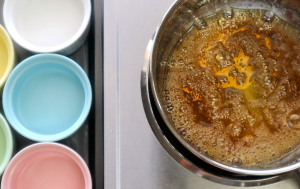
If this is your first time making caramel, be mindful of the heat and cooking time If this is your first time making caramel, be mindful of the heat and cooking time. Cooking the caramel for too long or at too high a temperature will result in a burnt, bitter flavour that can overpower the delicate nature of the flan. Conversely, if the caramel is not cooked long enough, it won’t develop the beautiful colour characteristic of the dessert. Make sure to remove the caramel from the heat at the right moment and immediately pour it into the ramekins (or moulds) so that it hardens before adding the custard. If the caramel remains liquid, it will mix with the custard, which is not how the flan should be made.
Q&As on Vietnamese Crème Caramel
1. How many flans does this recipe make, and what type of ramekins or moulds do you use?
This recipe makes about 6 flans when using my 3.5-inch (diameter) by 1.75-inch (height) ramekins. The resulting flans will be approximately 2.75 inches in diameter and 1 inch in height. Additionally, I use ramekins that come with their own lids, which are perfect for baking, steaming, and storing the flans in the fridge. I’ve included pictures of the ramekins here for easy reference!
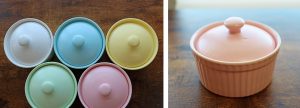
2. Why shouldn’t I use a spoon or spatula to stir the sugar and water mixture when making caramel?
When making caramel, it’s best not to use a spoon or spatula to stir the sugar and water mixture because it can cause the sugar to crystallize. Stirring introduces unwanted particles or air bubbles, which may cause the sugar to seize up and form crystals, resulting in a gritty texture. Instead, gently swirl the pot to ensure the mixture heats evenly, allowing the sugar to dissolve and caramelize smoothly.
3. I notice that other Vietnamese Crème Caramel (Bánh Flan) recipes suggest adding a bit of lime juice when making the caramel. I don’t see lime juice used in this recipe. Why is that?
This recipe follows the traditional method as I know it, passed down from my mom, who is an expert in making Bánh Flan. She never uses lime juice when making caramel. In one of my attempts, I did try adding lime juice, but the result was a caramel that had a sour note mixed with its sweetness, which didn’t taste pleasant and differed from the classic flavour I grew up with. For this reason, I don’t include lime juice in this recipe, sticking to the familiar, authentic taste.
4. I notice that other Vietnamese Crème Caramel (Bánh Flan) recipes suggest adding a small amount of vanilla extract. Why isn’t it included in this recipe?
This recipe follows the traditional method of making Bánh Flan, as passed down from my mom, which doesn’t include vanilla extract. I stick to this approach to preserve the classic flavour. However, unlike lime juice, vanilla extract could potentially enhance the flan’s flavour in a different way. If you’d like to try it, you can add about 1 teaspoon of vanilla extract when making the custard, following the same recipe. It’s a simple adjustment that might bring an extra layer of aroma to the dessert.
5. How do I check if my flan is fully cooked?
To check if your flan is fully cooked, gently insert a toothpick or skewer into the centre of the flan. If it comes out clean, with no custard sticking to it, the flan is set and ready. Another sign of doneness is a slight jiggle in the centre when you gently shake the ramekin – if the edges are firm and the centre moves slightly, it’s likely cooked through. Be careful not to overcook, as this can cause the flan to become dense or develop a grainy texture.
6. Why is my flan runny and not setting?
Flan can turn out runny and fail to set for several reasons:
- The ratio of eggs to milk is not balanced, with too few eggs used compared to the amount of milk. Typically, a ratio of 1 egg to 100-150 mL of milk is suitable. If too many eggs are used, the flan will become dense and dry. Conversely, if too few eggs are used, the flan will be runny and fail to set.
- The egg and milk mixture is not fully cooked; the steaming or baking time is insufficient.
- The cooking temperature is too low, preventing the eggs and milk from setting properly.
- The milk used has a low-fat content, resulting in a lack of thickness and creaminess.
To fix this issue, adjust the ratio of eggs to milk, increase the cooking time and temperature, or choose milk with a higher fat content.
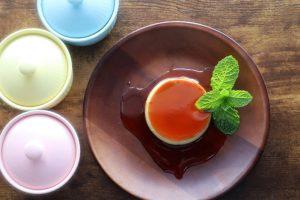
7. How long can I keep my flan in the fridge?
Flan can be stored in the fridge for up to 3 to 4 days. Make sure to cover the ramekins or place the flan in an airtight container to prevent it from absorbing any fridge odours. For the best texture and flavour, enjoy it within the first couple of days. Beyond 4 days, the flan may start to lose its smooth consistency and freshness.
8. Is it possible to make keto flan?
Update: I’ve just posted my Keto version of the Vietnamese Crème Caramel recipe. Check it out here: KETO Vietnamese Crème Caramel
Yes, it is possible to make a keto-friendly flan! I will be sharing a recipe for keto flan in the near future, so stay tuned for updates. It will use low-carb ingredients to keep the creamy texture and rich flavour while fitting into a keto diet.
For a keto-friendly flan, traditional ingredients like sugar and milk need to be replaced with low-carb alternatives to keep the dessert within keto guidelines. Here’s how you can make those substitutions:
Sugar Replacement
Instead of regular sugar, use a keto-approved sweetener such as erythritol, monk fruit sweetener, or allulose. These sugar substitutes are low in carbs and won’t spike blood sugar levels. Allulose is often preferred for keto flan because it caramelizes well and closely mimics the texture of real sugar.
Milk Replacement
For the milk, you can use unsweetened almond milk, coconut milk, or heavy cream. Heavy cream will provide a rich and creamy texture, similar to traditional flan, while unsweetened almond milk or coconut milk are lighter options with fewer carbs. A combination of heavy cream and almond milk can also be used for a balanced creaminess.
These substitutions ensure that the flan retains its smooth, custard-like texture while remaining low-carb and keto-friendly.
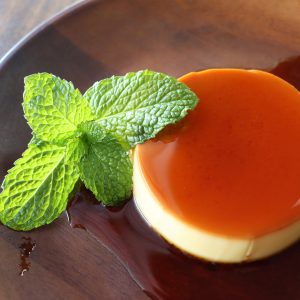
Recipe for Vietnamese Crème Caramel (Bánh Flan)
Equipment
- 1 steamer or oven
- 1 Pot
Ingredients
- 5 eggs
- 500 mL half-and-half (half milk and half cream)
- 160 grams condensed milk
- 100 grams sugar
- 50 mL water (for the caramel)
- 40 mL water (to add later to the caramel)
Instructions
- Make the Caramel:In a small pot, combine the sugar with 50 mL of water and place it over medium heat. Avoid using any tools to stir the mixture, as this can cause crystallization. Instead, gently swirl the pot from time to time to ensure even heating and dissolving of the sugar.Prepare the ramekins by placing them within easy reach. When the sugar mixture begins to turn a light yellow colour, carefully add 40 mL of water to the pot, continuing to swirl gently as the caramel darkens.Once the caramel has thickened and achieved a rich dark orange colour, promptly remove the pot from the heat to prevent it from burning.Immediately pour the caramel into the bottom of each ramekin, dividing it evenly among them. Allow the caramel to set and harden while you prepare the custard.
- Make the Custard:In a mixing bowl, crack all 5 eggs and separate the yolks from the whites, keeping 5 yolks and only 4 of the egg whites. Beat the egg yolks gently in a single direction until they become smooth and well-combined, taking care not to overbeat them.In a separate bowl, beat the egg whites gently, then add the beaten yolks to the whites. Mix the two together gently to create a uniform egg mixture.In a pot, combine the half-and-half and condensed milk, heating the mixture over medium heat. Stir the mixture gently but consistently to ensure that the ingredients are well blended without scorching.When the milk mixture becomes hot but has not reached a boil, remove it from the heat immediately.Gradually pour the hot milk mixture into the bowl with the egg mixture, stirring gently to blend the ingredients without creating air bubbles.Pass the mixture through a fine mesh strainer to remove any lumps, resulting in a smooth custard that will ensure a silky texture in the finished flan.Carefully pour the custard mixture into each ramekin over the hardened caramel, filling them evenly.
- Steam:Arrange the filled ramekins in a deep baking pan. Cover each ramekin to prevent condensation from dripping onto the custard. Pour water into the baking pan until it reaches halfway up the sides of the ramekins to create a water bath.Preheat the oven to 150°C (300°F) and place the baking pan with the ramekins inside. Steam the flan for approximately 1 hour and 30 minutes, or until the custard has set. To check if the flan is done, insert a toothpick into the centre; if it comes out clean, the flan is fully cooked.Carefully remove the ramekins from the oven and let them cool at room temperature for around 10 minutes before handling further.Once the flan has cooled, transfer the ramekins to the refrigerator and chill for at least 2 hours before serving to allow the flavours to meld and the texture to firm up.
- Serve:To unmould, run a small knife around the inside edge of each ramekin to loosen the flan. Invert the ramekin onto a serving plate, allowing the flan to slide out and the caramel sauce to drizzle over the top.Your Vietnamese Crème Caramel (Bánh Flan) is now beautifully prepared and ready to enjoy!

